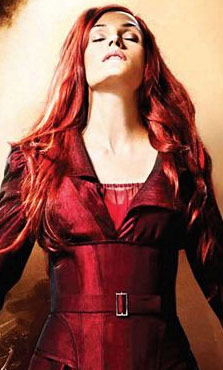
My acquaintance with “The Uncanny X-Men” began with issue #206, purchased from a corner liquor store along with a Hostess Lemon Pie. Both I devoured quickly, and both gave me the same sugary rush. #206 was concerned with one Rachel Summers, the daughter of Scott Summers and Jean Grey, also known as Cyclops and Phoenix. Rachel hailed from a different timeline in which Jean had never died, mutants had been hunted down by giant robots in a government-led genocide, and from which she had traveled back in time to prevent said genocide from occurring by joining with the X-Men and, along the way, accidentally acquiring massive amounts of cosmic power from a godlike entity from outer space called the Beyonder whom she was able to defeat by becoming an even more powerful version of her mother, the Phoenix, who in reality was not her mother but an omnipotent being made of pure energy that roamed the universe looking for organic hosts.
Got all that?
No, me neither. And this is why the comic book purist in me, who so enjoyed Bryan Singer’s first two respectful chapters of the “X-Men” film saga, couldn’t really complain about Brett Ratner’s uninspired use of Phoenix in the spastic third chapter. Not after what mother and daughter Phoenixes were put through in the comic books. Their stories were mauled every which way but loose by writers looking to reheat familiar story arcs to satisfy hungry readers. Story continuity and respect for characters are wholly alien to the original “X-Men” comic book, so why should it matter if Phoenix’s story is told properly in the cinematic version?
The comic book purist in me was more than content just to see Colossus hurl Wolverine in a Fastball Special, the perils of the Danger Room, and the apocalyptic mauve and orange of Dark Phoenix as she barbeques foes. In a nod to the mad immortality of pulp heroes, “X3” even manages to suggest, in its final frames, that two key characters, despite difficult setbacks—like, you know, death—may indeed be back in our multiplexes one day. These films don’t even pretend that death is final when everyone knows that resurrection is only a grumpy studio accountant’s call away. No, Ratner did justice to “The X-Men”. In fact, Ratner might have been uniquely qualified to deliver a product as incoherent and inconsistent as the entire series of books.
Which is to say that for all its mutant marvels, “X3” distracts us from its flaws long enough to enjoy its kinetic bounce. Any discussion of this film’s virtues, such as they are, must begin and end with the Alcatraz finale, which neatly sums up why “X3” is simultaneously wonderful and stupid. The idea of the mutant cure is clever (and comes from the comic books), but it’s only used to establish one set-piece action sequence on this island prison. Ratner and his digital artists give the scene some visual interest, but upon further reflection, it’s easy to see they rigged up exciting visuals to cover up for silly screenwriting. It’s hard to figure out who is dumber: the humans who thought holing up on Alcatraz would protect them from mutants who can fly and bend metal, or Magneto and Phoenix, two gravity-defying mutants, whose combined powers could destroy the planet, who nevertheless decide to use the Golden Gate Bridge to cross the bay to reach Alcatraz on foot. Okay, there is pleasure in watching as the Brotherhood of Lollapaloozans, like a giant mutant pride parade, dramatically cross the bay in all their tatted-up glory. Those powers must not come with user manuals, and that’s a good thing. If they did, mutants would battle with such efficiency their clashes would be dull to watch.
The X-Men are a merchandiser’s dream, considering there are an infinite number of action figures to introduce, and “X3” puts toy marketing on shuffle-play. New characters crowd the screen’s edges with powers, while older ones appear and disappear as if the film’s universe were in the hands of a capricious editor. Mystique, easily one of the best characters in the series, exits in a manner suggesting carelessness. The closest parallel to her death might be Boba Fett’s inglorious death in “Return Of The Jedi”, but even then Lucas allowed the monster that ate him a sumptious burp. Mystique’s final appearance is on closed-circuit TV; she’s cancelled, like a bad TV show, which says a lot about the care with which this story is told. Then again, maybe Mystique’s “cure” wasn’t supposed to be a tragic exit, since she lost only half her superpowers. She’s still a woman, after all. |